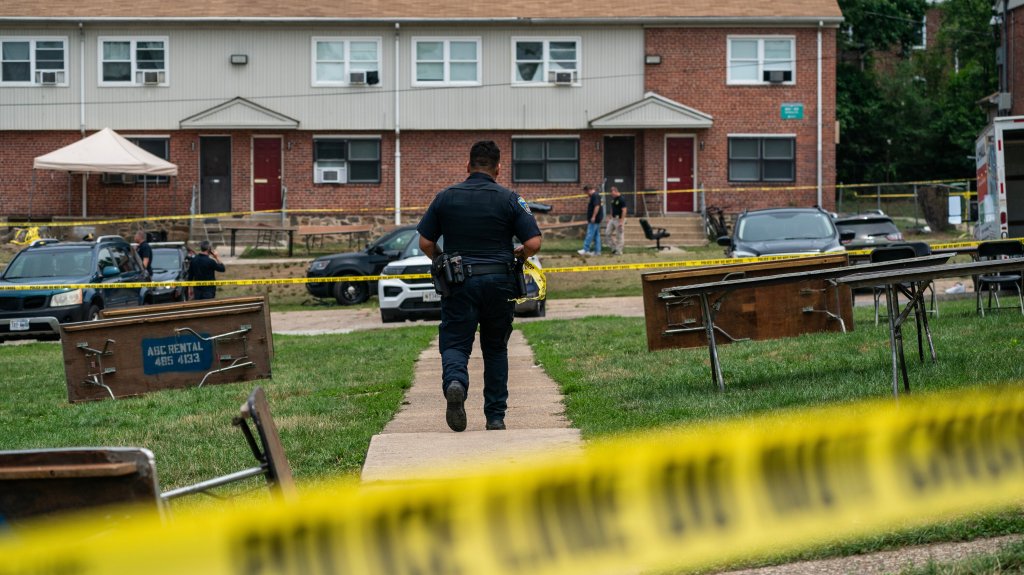Baltimore’s Brooklyn neighborhood was struck by a horrific mass shooting in the early hours of July 2nd, leaving two people dead and 28 others injured. The incident occurred shortly after 12:00 am on and around the 800 block of Gretna Court during a block party celebrating Brooklyn Day, an annual neighborhood celebration. The tragedy has ignited discussions about neglected communities, gun control, and police accountability.
The victims of the shooting have been identified as 18-year-old Aliyah Gonzalez and 20-year-old Kylis Fagbemi, whose lives were tragically cut short by this act of mass violence. The crime scene spanned multiple blocks and was left littered with casings from more than a dozen guns, indicating the involvement of multiple shooters. Ages of those shot range from 13 to 32, with 15 of the victims being under the age of 18.
The Baltimore Police Department (BPD) reported that they had no prior knowledge of the block party, blaming the lack of police presence on the fact that the event was celebrated by residents without a permit. According to witnesses, the department was made aware of the celebration as early as 5:30 pm when complaints about armed individuals and noise disturbances were made by residents. Furthermore, reports of fights were dismissed by the police at approximately 11:00 pm after the department flew a helicopter over the event, exacerbating concerns about the effectiveness of law enforcement in ensuring community safety in the neighborhood.
Responses to the mass shooting from city authorities such as the Mayor’s Office of Neighborhood Safety and Engagement (MONSE) and the Housing Authority of Baltimore City (HABC) matched the melody of those coming from the city’s acting Police Commissioner, Robert Worley, sharing a common theme of deflecting responsibility for the tragedy onto the community itself for failing to apply for a permit for the event, variously calling the annual block party a “non-sponsored,” “unsanctioned,” and “unpermitted” celebration. Meanwhile, residents and witnesses report that police were slow to come to the scene, even after being made aware of disturbances at the celebration. One resident of Gretna Court told reporters, “There was a big disturbance. Everybody called it in, but they [the police] took too long to get here.”
On Friday, July 7th, the police arrested a 17-year-old in connection to the shootout. The arrest was made after a video allegedly showing the teenager brandishing a gun at the event was circulated on social media. Mayor Brandon Scott released a statement on the teenager’s arrest, saying, “Today’s arrest is a signal that, with the community’s help, we can get justice for Aaliyah, Kylis and everyone who has been impacted by this tragedy, and Baltimoreans have my word that we will not rest until we do.” Meanwhile, Police Commissioner Worley announced a reward of $28,000 for any information leading to the identification and arrest of suspects involved in the shooting.
In her statement, Baltimore City Councilmember Phylicia Porter, who represents the neighborhood, accurately noted that “Brooklyn has forever and always been a neglected community.” Bordering northern Anne Arundel County and separated from the rest of Baltimore City by the Patapsco River, the South Baltimore neighborhoods of Brooklyn and Curtis Bay are a multi-racial, multi-lingual, working class exclave of Baltimore City characterized by a crisis of unemployment, drug addiction, sex trafficking, theft, decrepit homes, potholes, poverty, and violence that has been historically overlooked and forgotten by the city government.
Founded in the mid-19th century, Brooklyn initially flourished as a working-class neighborhood due to its proximity to Baltimore’s bustling port and industrial centers. The area became home to a diverse mix of immigrant communities, including Irish, Polish, Italian, and African American residents, who contributed to its vibrant cultural tapestry.
However, the neighborhood has faced numerous challenges over the past several decades. The trend of deindustrialization associated with the rising tide of neoliberalism in the late 20th century hit the community hard, resulting in a loss of jobs and opportunities. This decline, coupled with systemic issues such as poverty, racism, limited educational resources, and inadequate social services, has contributed to the neighborhood’s struggles with drugs, illegal weapons, and violence.
Brooklyn has been deeply impacted by the opioid crisis that has swept through Baltimore and many other parts of the United States. Residents have long witnessed the devastating effects of the drug war and the unsettling combination of criminal and police activity that accompany it. The availability of illicit substances and the resulting drug trade have fueled violence and created an atmosphere of instability for this working-class community while making millions of dollars for the owners of pharmaceutical companies like Purdue Pharma, the manufacturer of the highly addictive drug Oxycontin that can be found for sale in many of the neighborhood’s corners and alleyways.
Brooklyn’s struggles are not unique. It joins communities across the United States who have had to grapple with the challenges posed by the neoliberal onslaught that began in the late 20th century and which is only now beginning to show cracks in its hegemony. The tragedy on July 2nd and others like it underscore the need for comprehensive and sustainable solutions to the crises associated with capitalism’s decline such as community control of the police, living-wage union jobs, universal healthcare, and ultimately, systemic change for socialism.
The Baltimore City Council Public Safety and Government Operations Committee will be holding a public hearing on the mass shooting at 5:00 pm on July 13th.
-Written by The Baltimore Chapter of the CPUSA
